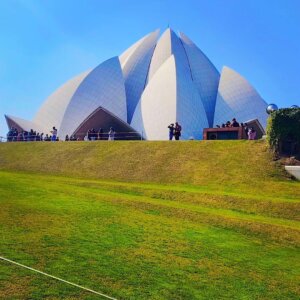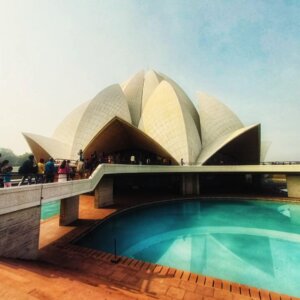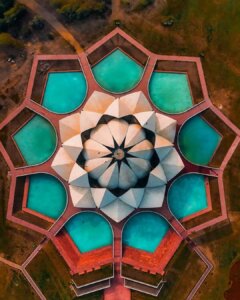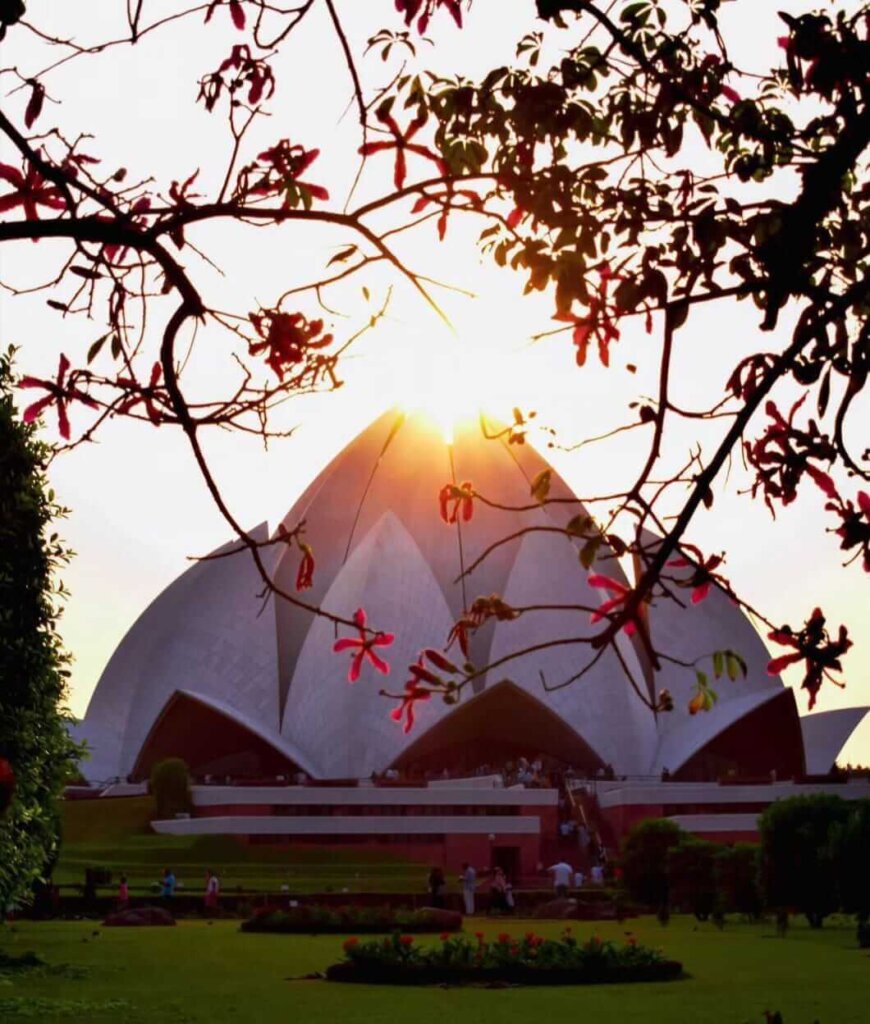“Lotus Temple: A Reflection of Peace in Delhi’s Bustling Landscape”
Introduction
The Lotus Temple, nestled in Delhi, India, is an awe-inspiring architectural wonder that transcends religious barriers, symbolizing harmony and togetherness. Erected in 1986, this magnificent temple has become a global pilgrimage destination, drawing countless visitors every year who seek solace and spiritual enlightenment.

The Lotus Temple is the central place of worship of the Bahá’í Faith, a monotheistic religion that emphasizes the oneness of God and the unity of all mankind. The unique design of the temple is perhaps its most distinctive feature – it takes the form of a blooming lotus flower, with 27 pristine white marble petals arranged in groups of three to form nine arms. The lotus is a universal symbol of purity, enlightenment and rebirth, making it a suitable representation for a structure that aims to promote unity and spiritual awakening.
The architect behind this masterpiece is Fariborz Sahba, an Iranian-born Canadian architect who seamlessly blends artistic vision with spiritual purpose. White marble sourced from the Penteli Mountains in Greece was used in the construction of the temple, adding a touch of timeless beauty to its exterior.
One of the most notable aspects of the Lotus Temple is its adherence to the principle of inclusivity. The Bahá’í Faith advocates the elimination of prejudice and the establishment of world peace, and the Lotus Temple embodies these principles by welcoming people of all religions, races and backgrounds. There are no statues, altars or religious symbols inside the temple, emphasizing its commitment to the idea that all paths lead to the same ultimate truth.
Surrounded by lush greenery and reflecting ponds, the Lotus Temple offers a serene and contemplative environment. It is not just a place of worship; It is a place for individuals to find solace, contemplate the profound teachings of the Bahá’í Faith, and experience a sense of unity in diversity. As you step into the Lotus Temple, you are not just entering a religious institution but immersing yourself in an architectural and spiritual masterpiece that exudes the beauty of unity and peace amidst the bustling landscape of Delhi. Reflects.
Historical Background:Lotus Temple
The Lotus Temple, located in the heart of Delhi, India, has its origins deeply rooted in the principles and teachings of the Bahá’í Faith. The Bahá’í Faith, founded by Bahá’u’lláh in the mid-19th century, emphasizes the unity of God, the unity of all religions, and the essential harmony between science and religion. It advocates the elimination of prejudices and the establishment of world peace.
The idea to build the Lotus Temple emerged as part of the Bahá’í community’s commitment to creating spaces that foster unity and inclusivity. The governing body of the Bahá’í Faith, the Universal House of Justice, called for the construction of houses of worship around the world to serve as centers of worship and places for people of all backgrounds to gather in prayer and meditation.
The concept of the Lotus Temple was conceived by architect Fariborz Sahba, who sought to create a structure that would not only reflect the teachings of the Bahá’í Faith but would also symbolize the sacredness, beauty and universality of the divine. The lotus flower, which has deep cultural and religious significance in various traditions, was chosen as the design inspiration. The lotus symbolizes purity, enlightenment and rebirth, making it a fitting representation for a space dedicated to promoting spiritual awakening and inclusivity.

Construction of the Lotus Temple began in 1980 and it took approximately six years to complete this architectural masterpiece. The project involved the collaboration of many engineers, artisans and volunteers who dedicated their efforts to bringing the vision of the Lotus Temple to life.
The Lotus Temple stands as a testament to the Bahá’í principles of unity, peace and the elimination of prejudice. Its origins lie in a deep commitment to creating a place where people of all religions can come together to worship, meditate and contemplate the essential unity of humanity. As a result, the Lotus Temple continues to attract tourists from all over the world, attracted not only by its stunning architecture but also by the spiritual principles that inspired its construction.
Architectural Marvel:
The architectural genius of the Lotus Temple goes beyond its aesthetic appeal; It has been intricately designed to enhance a profound sense of peace to its visitors. The unique structure, resembling a blooming lotus flower with 27 antique white marble petals, contributes to an atmosphere of peace and tranquility.
Firstly, the symbolism of the lotus flower is key to creating a serene atmosphere. In Hinduism, Buddhism, and various other spiritual traditions, the lotus is a symbol of purity, enlightenment, and rebirth. The use of this universally acclaimed symbol in the design instantly instills a sense of spiritual upliftment and sanctity among the people visiting the temple. The visual impact of the lotus, combined with these positive concepts, creates an atmosphere of peace even before entering the temple.
The architecture also prioritizes natural light, filtering through the petals and providing a soft, diffused glow inside. This deliberate use of lighting creates an ethereal and serene atmosphere. The play of light and shadow, along with the reflecting pools surrounding the Lotus Temple, enhance the feeling of calm, encouraging visitors to contemplate and meditate.
Furthermore, the absence of religious symbols, statues or altars within the temple reinforces the inclusivity of the place. Visitors from any religious or cultural background can enter without feeling any specific ideological impact, promoting a universal feeling of peace. The absence of religious iconography allows individuals to connect with their spirituality on a personal level, further contributing to the tranquil atmosphere.
The Lotus Temple’s spacious, open interior, designed to accommodate a large number of people, ensures that visitors can have their own quiet space for reflection. Whether one wishes to sit in silent contemplation or absorb the beauty of the surroundings, architecture encourages a meditative state.
In short, the design of the Lotus Temple is a masterful creation of symbolism, natural elements and inclusivity, working harmoniously to create an environment where the mind can find peace, and the soul at peace amidst the bustling landscape of Delhi. Can experience.
The Lotus Temple Experience:
Stepping into the Lotus Temple is an exquisite experience that mesmerizes visitors from the moment they approach its majestic white lotus petals. The tour begins at the entrance gates, where a quiet path leads to the central hall. As visitors pass through this path, there is a palpable sense of anticipation, guided by the view of the lotus slowly opening before them.

The exterior of the Lotus Temple, with its ancient marble petals reaching towards the sky, evokes a feeling of reverence and awe. Tourists often find themselves stopping to absorb the beauty of the structure, its architectural beauty reflects the sacredness and grace associated with the lotus flower in various cultural and religious contexts.
Upon crossing the threshold into the central chamber, a serene atmosphere prevails. The spacious, open interior welcomes guests with a sense of expanse, a stark contrast to the bustling city landscape left behind. Natural light filtering through the petals casts a gentle glow, creating an ethereal ambiance that enhances the feeling of peace.
Inside, there are no prescribed rituals or formalities. Visitors are free to choose how they wish to engage with the space – whether through silent contemplation, meditation, or simply absorbing the peaceful atmosphere. The absence of religious symbols or idols allows individuals to connect with their spirituality on a personal level, fostering a universal feeling of unity and peace.
The architecture of the Lotus Temple encourages a meditative state, inviting visitors to contemplate their beliefs and find solace in silence. The interplay of light, harmonious design and the inclusive ethos of the Bahá’í Faith create an environment where the visitor’s perspective shifts from curiosity to a deep connection with the spiritual essence of the Lotus Temple. It is not just a place of worship, but a sanctuary that resonates with the diverse perspectives and desires of all who enter, offering a unique and deeply personal encounter with the sacred.
Harmony of Religions:
The Lotus Temple stands as a testament to the principles of the Bahá’í Faith, a monotheistic religion founded by Bahá’u’lláh in the mid-19th century. The Bahá’í Faith revolves around several core principles that emphasize the oneness of God, the oneness of humanity, and the essential harmony between religion and science.
Central to the Bahá’í Faith is the belief in the unity of God, which portrays a singular and transcendent Deity who is the source of all creation. This theory lays the foundation for the unity of all religions, claiming that each major world religion represents a stage in humanity’s spiritual evolution and contributes to overall progress toward global unity.
The Lotus Temple reflects the Bahá’í commitment to the unity of humanity. Adopting a design free of religious symbols, idols or rituals, the temple welcomes individuals of all religions, castes and backgrounds. It stands as the physical embodiment of the Bahá’í principles of unity in diversity, fostering a place where people can come together in harmony, transcending the barriers that often divide society.
Furthermore, the Bahá’í Faith advocates the elimination of prejudice, promoting the idea that all persons are equal in the eyes of God. This commitment to social justice and equality is reflected in the inclusive ethos of the Lotus Temple, which encourages a sense of unity and respect among its diverse visitors.
The principles of the Bahá’í Faith extend beyond the walls of the Lotus Temple, emphasizing the importance of education, the equality of men and women, and the establishment of world peace. Through these principles, the Bahá’í community seeks to contribute to the betterment of society and the achievement of a more integrated and just world.
In short, the Lotus Temple is not just a place of worship; It is a physical expression of the profound principles of the Bahá’í Faith, providing a sacred space where individuals can contemplate the oneness of God, the oneness of humanity, and the search for a more harmonious and inclusive world.
Amidst Delhi’s Chaos:
Situated amidst the bustling landscape of Delhi, the Lotus Temple presents a stark and deliberate contrast with the fast-paced and chaotic rhythm of the city. As one approaches the temple, the noise of urban life gradually transforms into a serene atmosphere that seems almost unreal against the backdrop of the bustling metropolis.
The urban landscape of Delhi, characterized by blaring horns, crowded streets and a constant bustle of activity, serves as a dynamic and vibrant stage for the serene presence of the Lotus Temple. The architectural brilliance of the temple, with its white marble lotus petals rising towards the sky, is a stark contrast to the concrete and steel structures that dominate the city’s landscape.
Entering the temple complex is like stepping into a different realm. The lush green surroundings, coupled with the reflecting ponds, create a peaceful oasis that provides respite from the frenetic energy of Delhi. The absence of the usual urban sounds has been replaced by a gentle calm, inviting visitors to leave the hustle and bustle of urban life behind.
Inside the Lotus Temple, the contradiction becomes even more apparent. The spacious interiors, free of religious symbols and furnished with minimalist elegance, promote a feeling of openness and peace. Tourists find themselves immersed in a meditative environment away from the sensory overload of the city.
Lotus Temple’s deliberate retreat from the chaos of the city serves a larger purpose. It inspires individuals to stop, reflect and find a moment of peace amidst the urban frenzy. It stands as a reminder that amidst the constant hustle and bustle of the city, there exists a place where one can find solace, connect with one’s spirituality and experience a profound sense of peace. In this way, the Lotus Temple not only contrasts Delhi’s bustling urban landscape, but also provides a harmonious counterpoint, inviting visitors to discover a sanctuary of peace amidst urban dynamics.
Community Initiatives:
The Lotus Temple in Delhi goes beyond its role as a place of worship to actively contribute to community development, while embodying the principles of the Bahá’í Faith. Beyond its architectural grandeur, the temple serves as a focal point for various community-centric initiatives aimed at promoting unity, education and social welfare.
A key aspect of Lotus Temple’s community engagement is its commitment to educational programs. The temple organizes a number of activities, workshops and discussions that aim to promote intellectual and moral development. These initiatives are not limited to religious teachings but extend to a broader understanding of the arts, sciences and humanities. The emphasis on education is consistent with Bahá’í doctrine which views knowledge as a powerful force for individual and collective progress.
Lotus Temple also plays an important role in promoting arts and cultural promotion within the community. Cultural events, concerts and exhibitions organized at the temple provide a platform for local artists to showcase their talents, contributing to the cultural vibrancy of the surrounding area. This cultural engagement is consistent with the Bahá’í principle of the unifying power of the arts in bringing diverse communities together.
Additionally, Lotus Temple actively engages in social and humanitarian efforts. Through outreach programs and collaborations with local organizations, the temple addresses issues such as health care, poverty alleviation, and environmental sustainability. This commitment to social welfare reflects the Bahá’í principle of service to humanity and the belief that spiritual and material progress are interdependent.
In short, Lotus Temple’s role in community development extends beyond spiritual enrichment to include a holistic approach that addresses the educational, cultural and social needs of the community. It stands as a symbol of unity and service, embodying the principles of the Baha’i Faith and contributing to the betterment of the wider community in Delhi. The Temple’s multifaceted involvement underscores its commitment to creating a harmonious and progressive society that is consistent with the ideals of the Bahá’í Faith.
Conclusion:
The Lotus Temple, with its iconic lotus-shaped architecture and serene surroundings, stands as a resolute beacon of peace in the heart of Delhi. Reinforcing its role as a symbol of tranquility amidst the bustling cityscape, the temple embodies a profound commitment to fostering harmony, unity, and spiritual reflection.
At the heart of the Lotus Temple’s role as a beacon of peace is its architectural design. The lotus flower, a universal symbol of purity and enlightenment, serves as a visual metaphor for the spiritual awakening that the temple represents. The pristine white marble petals, gracefully unfolding, evoke a sense of beauty and serenity. As the lotus rises from the muddy waters unstained, so does the Lotus Temple rise above the chaotic urban landscape, offering a sanctuary for those seeking solace.
The intentional location of the Lotus Temple contributes to its significance as a beacon of peace. Situated amidst the vibrancy of Delhi, a city known for its energetic pace and diverse population, the temple serves as a counterpoint to the frenetic urban life. Its presence becomes even more poignant as visitors transition from the noisy, bustling streets to the tranquil environs of the temple. This deliberate contrast reinforces the temple’s role as a haven where individuals can escape the urban clamor and connect with a deeper, more serene aspect of themselves.
Moreover, the Lotus Temple’s inclusive ethos amplifies its impact as a symbol of peace. By embracing individuals from all walks of life, irrespective of their religious affiliations, the temple fosters a sense of unity and shared humanity. The absence of religious symbols within the temple’s interior underscores its commitment to transcending religious boundaries, reinforcing the idea that peace is a universal aspiration that unites people beyond cultural or faith-based differences.
The temple’s lush gardens and reflective pools add an extra layer of symbolism, mirroring the quest for inner reflection and spiritual peace. Visitors are invited to engage in silent contemplation, finding a space for personal introspection amidst the carefully manicured greenery. The serene pools, mirroring the lotus petals above, further contribute to the calming atmosphere, creating a visual metaphor for the reflective and peaceful state of mind sought by those who enter.
Beyond its physical presence, the Lotus Temple actively promotes peace through community engagement. By hosting educational programs, cultural events, and humanitarian initiatives, the temple becomes a catalyst for positive change within the community. These efforts align with the Bahá’í principles of unity, service to humanity, and the pursuit of knowledge as a force for progress.
In conclusion, the Lotus Temple’s role as a beacon of peace in Delhi is multifaceted. Its architectural design, strategic location, inclusive ethos, and community engagement collectively reinforce its significance as more than a place of worship. It is a sanctuary that radiates tranquility, inviting individuals to find peace within themselves and fostering a collective sense of harmony that extends beyond the temple’s walls into the broader fabric of Delhi’s diverse society.

